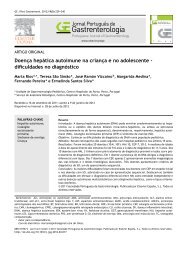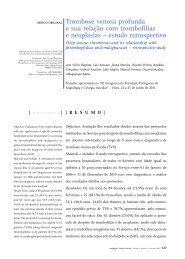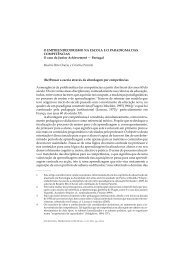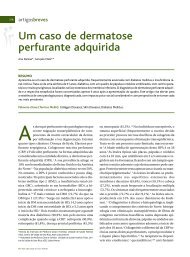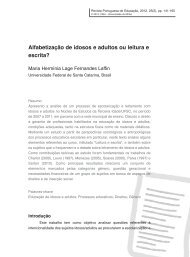Predicting Defoliation by Pine Processionary Caterpillar ... - SciELO
Predicting Defoliation by Pine Processionary Caterpillar ... - SciELO
Predicting Defoliation by Pine Processionary Caterpillar ... - SciELO
Create successful ePaper yourself
Turn your PDF publications into a flip-book with our unique Google optimized e-Paper software.
Silva Lusitana, nº especial: 79 - 88, 2011<br />
© UISPF, L-INIA, Oeiras. Portugal 79<br />
<strong>Predicting</strong> <strong>Defoliation</strong> <strong>by</strong> <strong>Pine</strong> <strong>Processionary</strong> <strong>Caterpillar</strong>,<br />
Thaumetopoea wilkinsoni (Lepidoptera: Notodontidae) in<br />
Young Pinus brutia Plantations in Northern Cyprus<br />
William M. Ciesla 1 , Musa Erkanat 2 and Cemal Akeson 2<br />
1Forest Health Management International, Fort Collins, CO, USA<br />
2Forest Department, Turkish Republic of Cyprus, Nicosia, CYPRUS<br />
Abstract. A method is described for predicting severity of defoliation of young Pinus brutia<br />
plantations (
80 Ciesla, W.M., Erkanat, M. and Akeson, C.<br />
and the U.S. Agency for International<br />
Development (USAID) for management<br />
of an outbreak of pine processionary<br />
caterpillar that was causing defoliation of<br />
young pine plantations. One of the<br />
technical services requested was the<br />
development of criteria according to<br />
which plantations would be treated.<br />
The concept<br />
The work was focused on young pine<br />
plantations with trees up to 2.5 meters in<br />
height. Estimates of both egg-mass and<br />
larval colony numbers were based on<br />
whole trees.<br />
The envisioned end product of this<br />
work was to:<br />
1. Determine optimum sample size<br />
for estimating the number of egg<br />
masses and early instar larval<br />
colonies.<br />
2. Establish a relationship between<br />
egg-mass counts, larvae and<br />
defoliation at the end of the larval<br />
feeding period that could be used<br />
to predict defoliation intensity.<br />
3. Establish thresholds of egg-mass<br />
and larval colony numbers to<br />
determine the need for control<br />
and type of control using a twothreshold<br />
system:<br />
a. Below threshold 1, no action<br />
would be taken.<br />
b. Above threshold 1, mechanical<br />
control consisting of<br />
removal of pine processsionary<br />
caterpillar colonies<br />
would be undertaken.<br />
c. Above threshold 2, aerial or<br />
ground applications of the<br />
biological insecticide Bacillus<br />
thuringiensis would be<br />
applied.<br />
Methods<br />
Optimum sample size<br />
In order to establish a sound basis for<br />
selection of sample size (number of trees<br />
in a plantation), egg-mass data collected<br />
in December 2000 from two adjoining<br />
Pinus brutia plantations in the<br />
Diorios/Tepebasi Forest, Northern<br />
Cyprus, were analyzed. The plantations<br />
were established in 1987 and the trees<br />
were somewhat less than 2 meters in<br />
total height at the time of data collection.<br />
Counts of the total number of pine<br />
processionary caterpillar egg masses<br />
were made on each of 30 sample trees<br />
per plantation. The sample trees were<br />
selected randomly along a diagonal line<br />
across each plantation.<br />
The following statistics were<br />
computed for each plantation and for the<br />
two plantations combined:<br />
1. Average number of egg-masses/<br />
tree<br />
2. Range of egg-mass numbers<br />
3. Standard deviation<br />
4. Standard error<br />
5. 95 and 99% confidence limits<br />
Using a procedure described <strong>by</strong><br />
FREESE (1967), the optimum number of<br />
sample trees was determined from the<br />
following relationship:<br />
n=t 2 s 2<br />
E 2<br />
where:<br />
n = Optimum sample size<br />
t = Value of t at n-1 degrees of<br />
freedom<br />
s = Standard deviation of the mean<br />
number of egg-masses per tree<br />
e = Level of precision desired (± x egg<br />
masses/tree)
<strong>Predicting</strong> <strong>Defoliation</strong> <strong>by</strong> <strong>Pine</strong> <strong>Processionary</strong> <strong>Caterpillar</strong> 81<br />
The optimum number of sample trees<br />
needed was determined for each<br />
plantation and the two plantations<br />
combined, for the following levels of<br />
precision:<br />
± 2 egg masses 95 out of 100 times<br />
± 1 egg mass 95 out of 100 times<br />
± 2 egg masses 99 out of 100 times<br />
± 1 egg mass 99 out of 100 times<br />
Average egg masses per tree for<br />
plantations 1 and 2 were 5.97 and 6.97<br />
respectively. The range of egg masses per<br />
tree varied from 0-24 in plantation 1 and<br />
0-45 in plantation 2 (Table 1). Other basic<br />
statistics about each plantation and the<br />
two plantations combined are<br />
summarized in Table 1.<br />
Recommendation for optimum<br />
sample size is based on average eggmass<br />
densities, their variability and on<br />
practicality. The best combination<br />
appears to be to attempt to achieve a<br />
precision of ± 2 egg masses 95 out of 100<br />
times. This resulted in a required sample<br />
size of 33 trees in plantation 1 and 72<br />
trees in plantation 2 (Table 2). The larger<br />
optimum number of sample trees in<br />
plantation 2 is attributed to the wider<br />
range of egg-mass numbers per tree<br />
(0-45) The combined data show an<br />
optimum sample size of 52 trees per<br />
plantation (Table 2).<br />
Table 1 - Egg mass densities and sampling errors for two pine plantations in the<br />
Diorios/Tepebasi Forest, Northern Cyprus, December 2000<br />
Statistical Parameter Plantation 1 Plantation 2 Combined<br />
Sample size (Number of trees) 30 30 60<br />
Mean (Egg masses/tree) 5.97 6.87 6.42<br />
Range (Egg masses/tree) 0-24 0-45 0-45<br />
Standard deviation 5.77 8.53 7.24<br />
Standard error 1.05 1.56 0.93<br />
95% confidence limits<br />
(Egg masses/tree)<br />
±2.15 ±3.18 ±1.91<br />
99% confidence limits<br />
(Egg masses/tree)<br />
±2.59 ±3.83 ±2.30<br />
Table 2 - Optimum sample sizes for estimating numbers of pine processionary caterpillar egg-<br />
-masses/tree in the TCC on trees up to 2 m in height based on data collected from two<br />
plantations in the Diorios/Tebebasi Forest, Northern Cyprus, December 2000<br />
Plantation<br />
Mean Egg-<br />
Masses/Tree<br />
Standard<br />
Deviation<br />
Number of Trees to Sample<br />
± 2 egg masses ± 1egg mass<br />
99% 95%<br />
confidence confidence<br />
limits limits<br />
95%<br />
confidence<br />
limits<br />
99%<br />
confidence<br />
limits<br />
1 5.97 5.77 33 56 133 222<br />
2 6.87 8.53 72 121 290 485<br />
Combined 6.42 7.24 52 87 209 349
82 Ciesla, W.M., Erkanat, M. and Akeson, C.<br />
Egg-mass and larval colony surveys<br />
Thirty sample plantations were<br />
selected throughout the Pentadactylos<br />
(Five-Finger) Mountains for eggmass/larval<br />
surveys in the 2002-2003<br />
field season. These plantations were<br />
established between 1986 and 1998 and<br />
consisted of trees up to 2.5 meters in<br />
height. Some were pure Pinus brutia<br />
plantations and others were mixed<br />
plantations of P. brutia, P. halepensis and<br />
Cupressus sempervirens. Between 30 and<br />
45 sample trees (P. brutia and P.<br />
halepensis) were selected on parallel<br />
transects across each plantation (Figure<br />
1). Each tree was numbered and<br />
examined for presence of egg-masses<br />
and larval colonies. Data for each tree<br />
was recorded on a field data sheet.<br />
Elevation (meters) was also recorded for<br />
each plantation.<br />
Fourteen of the plantations were<br />
examined for egg-masses from 9-11<br />
October 2002. These were recounted in<br />
early December because of problems<br />
with the first set of egg-mass counts.<br />
Counts of egg-masses and larval colonies<br />
were done simultaneously in early<br />
December for the remaining sample<br />
plantations.<br />
PLANTATION BOUNDARY<br />
SAMPLE TREES<br />
Figure 1 – Sample trees along diagonal transects in a pine plantation for egg-mass and larval<br />
colony sampling
<strong>Predicting</strong> <strong>Defoliation</strong> <strong>by</strong> <strong>Pine</strong> <strong>Processionary</strong> <strong>Caterpillar</strong> 83<br />
Rating defoliation<br />
A method for classifying the intensity<br />
of defoliation on sample trees was<br />
adopted from a procedure developed in<br />
North America for rating the intensity of<br />
infestation in conifers <strong>by</strong> parasitic dwarf<br />
mistletoes, Arceuthobium spp. This<br />
system, referred to as the Hawksworth<br />
6-class rating system (HAWKSWORTH,<br />
1977) consists of dividing the tree crown<br />
into three levels and rating severity of<br />
infection into three numerical classes<br />
(Figure 2). The sum of the crown ratings<br />
is the tree rating and the plot rating is<br />
the average value of the tree ratings.<br />
For pine processionary caterpillar, the<br />
three numerical classes were:<br />
0 – No defoliation present<br />
1 - < 50% of the branches defoliated<br />
and/or larval colonies present<br />
2 - > 50% of the branches defoliated<br />
and/or larval colonies present<br />
This rating system provides a range<br />
of individual tree and plot ratings from 0<br />
to 6 depending on the severity of<br />
defoliation.<br />
INSTRUCTIONS<br />
EXAMPLE<br />
STEP 1 - DIVIDE LIVE CROWN INTO THIRDS<br />
STEP 2 - RATE EACH THIRD SEPARATELY<br />
0 = NO VISIBLE INFESTATIONS<br />
1 = LIGHT (< THAN ½ OF<br />
BRANCHES WITH TENTS AND<br />
DEFOLIATION<br />
2 = HEAVY (> THAN ½ OF<br />
BRANCHES WITH TENTS AND<br />
DEFOLIATION<br />
STEP 3 - ADD RATINGS FOR EACH<br />
THIRD FOR A TREE<br />
RATING<br />
0<br />
1<br />
2<br />
THIS THIRD IS UNINFESTED<br />
= 0<br />
THIS THIRD IS LIGHTLY<br />
INFESTED = 1<br />
THIS THIRD IS HEAVILY<br />
INFESTED = 2<br />
0 + 1 + 2 = A PPC<br />
RATING OF 3<br />
Figure 2 – <strong>Pine</strong> processionary caterpillar rating system adapted from HAWKSWORTH (1977)
84 Ciesla, W.M., Erkanat, M. and Akeson, C.<br />
Results<br />
Timing of egg-mass surveys<br />
Initial screening of the data from<br />
sample plantations in which egg-mass<br />
surveys were conducted in early October<br />
had higher larval colony counts than<br />
egg-masses. Recounts of egg-mass<br />
numbers in these plantations during<br />
early December indicated that more egg<br />
masses were found in December.<br />
October egg-mass counts ranged from 33<br />
to 94.2% of the egg masses found in<br />
December (Table 3). This discrepancy in<br />
egg-mass counts was believed to be the<br />
result of three possible scenarios:<br />
1. October egg-mass surveys had<br />
been conducted before adult<br />
flight and oviposition were<br />
completed.<br />
2. Egg-masses produce more than<br />
one larval colony.<br />
3. Field crews did not detect all<br />
egg-masses present.<br />
If this discrepancy was due to egg-<br />
-mass surveys being done before adult<br />
flight was completed, the greatest<br />
discrepancy between the two sets of egg-<br />
-mass counts should have occurred in the<br />
low elevation plantations where adult<br />
flight and oviposition occurs later than at<br />
the high elevations (BUXTON, 1983).<br />
However, comparison of the proportion<br />
of egg-masses detected in October <strong>by</strong><br />
elevation failed to show a clear trend<br />
(Table 4). It is, therefore, believed that<br />
the discrepancies between the October<br />
and December egg-mass counts are the<br />
result of all three factors listed earlier.<br />
Egg-mass counts taken in December<br />
were used in the analysis.<br />
Table 3 - Percentage of <strong>Pine</strong> <strong>Processionary</strong> <strong>Caterpillar</strong> Egg Masses Detected <strong>by</strong> First Egg-Mass<br />
Sample, Five-Finger Mountains, Northern Cyprus, 2002<br />
Sample<br />
Plantation<br />
Elevation<br />
(meters)<br />
Date of<br />
Early Sample<br />
% of Egg Masses<br />
Detected on Early<br />
Sample*<br />
1 99 10 October 100.0<br />
2 439 11 October 94.2<br />
3 550 11 October 67.4<br />
4 211 11 October 80.2<br />
5 175 10 October 38.7<br />
6 180 9 October 60.8<br />
7 132 9 October 33.3<br />
8 220 9 October 90.0<br />
9 204 9 October 87.5<br />
10 172 10 October 25.0<br />
11 139 10 October 85.0<br />
12 89 10 October 57.0<br />
13 172 10 October 88.2<br />
16 138 10 October 64.7<br />
* (Number of egg masses detected October/Number of egg masses detected<br />
December) * 100
<strong>Predicting</strong> <strong>Defoliation</strong> <strong>by</strong> <strong>Pine</strong> <strong>Processionary</strong> <strong>Caterpillar</strong> 85<br />
Table 4 - Percent of Egg Masses Detected <strong>by</strong> First-Egg Mass Sample, <strong>by</strong> Elevation Zone, Five-<br />
Finger Mountains, Northern Cyprus, 2002<br />
Elevation Zone<br />
(Meters)<br />
Percent of Egg Masses Detected *<br />
(Range)<br />
Number of Plantations<br />
in Elevation Zone<br />
< 100 57.0 – 100.0 2<br />
100-149 33.3 – 85.0 3<br />
150-199 25.0 – 88.2 4<br />
200-249 87.5 – 90.2 3<br />
> 400 67.4 – 94.2 2<br />
* (Number of egg masses detected October/Number of egg masses detected December) * 100<br />
Table 5 - Distribution of Sample Plantations <strong>by</strong> Egg-Mass and Larval Densities, Five-Finger<br />
Mountains, Northern Cyprus, 2002<br />
Density Class Number of Plantations<br />
(Number per tree) Egg Masses Larval Colonies<br />
0.00 – 0.49 8 7<br />
0.50 – 0.99 4 9<br />
1.00 – 1.49 8 6<br />
1.50 – 1.99 3 0<br />
2.00 – 2.49 0 2<br />
2.50 – 2.99 2 2<br />
3.00 – 3.49 2 2<br />
3.50 – 3.99 1 1<br />
4.00 – 4.49 2 1<br />
Total 30 30<br />
Data ranges<br />
The average number of eggmasses/tree<br />
for the 30 sample plantations<br />
ranged from a low of 0.20 to a high<br />
of 4.23. These were lower than the values<br />
obtained for the two plantations sampled<br />
in 2000. Larval colony densities per tree<br />
ranged from 0.20 to 4.49. Estimates of<br />
larval colonies were higher than<br />
estimates of egg-masses/tree in 11 of the<br />
sample plantations (Table 5).<br />
Estimates of precision<br />
Estimates of numbers of egg-mass<br />
densities per tree was within ± 0.5 egg-<br />
-masses/ tree 95 out of 100 times in 25<br />
out of the 30 sample plantations and<br />
within ±0.69 egg masses on the<br />
remaining sample plantations. This was<br />
considerably higher than the expected<br />
precision of ± 2 egg-masses 95 out of 100<br />
times based on the data collected in 2000,<br />
especially considering that none of the<br />
sample plantations contained the<br />
recommended number of 50 sample<br />
trees. This is believed to be due to higher<br />
numbers of egg-masses on individual<br />
sample trees in 2000. One of the trees<br />
sampled in 2000 had 45 egg-masses<br />
(Table 1). This is probably unusual and<br />
adversely affected the estimate of<br />
sampling error. In 2002, the highest egg-
86 Ciesla, W.M., Erkanat, M. and Akeson, C.<br />
mass count obtained on a single tree was<br />
15.<br />
The precision of estimates of the<br />
numbers of larval colonies per tree was<br />
similar to the estimates of egg-mass<br />
densities. In 25 of the 30 sample<br />
plantations, estimates were within 0.5<br />
larval colonies 95 out of 100 times. In the<br />
remaining five plantations, the estimate<br />
was within ±0.67 larval colonies/tree.<br />
Egg-mass/ Larval colony/ <strong>Defoliation</strong><br />
correlations<br />
Regression analyses using the linear<br />
model y = a + bx (FREESE, 1978) was<br />
made for three relationships:<br />
1- Egg masses/ tree (x) vs. early<br />
instar larval colonies/ tree (y)<br />
2 - Egg masses/ tree (x) vs.<br />
defoliation rating (y)<br />
3 - Early instar larval colonies/ tree<br />
(x) vs. defoliation rating (y)<br />
Each of these models showed a strong<br />
positive correlation between the<br />
dependent and independent variables<br />
with correlation coefficients (r 2 ) ranging<br />
between 0.689 and 0.79 (Table 6).<br />
Two decision tables were developed<br />
based on these relationships (Tables 7 –<br />
8). One was based on the correlation of<br />
defoliation rating over egg-masses/tree<br />
and a second was based on the<br />
correlation of numbers of instar II and III<br />
larval colonies over egg-masses per tree<br />
and the correlation of defoliation over<br />
numbers of egg-masses/tree. These<br />
provide a basis for one of three pest<br />
management decisions: 1 – No action, 2 –<br />
Prune infested branches or 3 – treat<br />
plantation with aerial or ground sprays<br />
of the biological insecticide Bacillus<br />
thuringiensis. The output from these<br />
tables is virtually identical and both lead<br />
to the same decisions regarding<br />
recommended pest management actions.<br />
Discussion and conclusions<br />
Counts of egg masses and/or early<br />
larval colonies of pine processionary<br />
caterpillar can be used to forecast<br />
intensity of defoliation and can serve as<br />
the decision criteria for management of<br />
pine processionary caterpillar in young<br />
pine plantations (trees up to 2.5 m in<br />
height) in northern Cyprus. This method<br />
has now been in use for several years.<br />
Table 6 – Regression equations and correlation coefficients (r 2 ) for pine processionary<br />
caterpillar egg masses/ tree, early instar larval colonies/ tree and defoliation rating, Northern<br />
Cyprus, 2002 -2003<br />
Relationship<br />
Egg masses/ tree (x) vs. early<br />
instar larval colonies/ tree (y)<br />
Egg masses/ tree (x) vs.<br />
defoliation rating (y)<br />
Early instar larval colonies/ tree<br />
(x) vs. defoliation rating (y)<br />
Regression Equation<br />
y = a + bx<br />
Correlation<br />
Coefficient (r 2 )<br />
y = 0.08 + 0.83x 0.776<br />
y = 0.55 + 0.99x 0.698<br />
y = 0.59 + 1.16x 0.79
<strong>Predicting</strong> <strong>Defoliation</strong> <strong>by</strong> <strong>Pine</strong> <strong>Processionary</strong> <strong>Caterpillar</strong> 87<br />
Table 7 - Predicted defoliation and recommended control actions for pine processionary<br />
caterpillar in young Pinus brutia plantations in the TCC based on the regression of defoliation<br />
rating over egg-masses/tree (y = 0.55 + 0.99x) - 2002-2003<br />
Egg Masses/<br />
Tree<br />
Predicted<br />
<strong>Defoliation</strong><br />
Rating<br />
Range<br />
(95 % Confidence<br />
Limits)<br />
0.0 0.55 0.15 – 0.95<br />
0.5 1.05 0.71 - 1.38<br />
1.0 1.54 1.23 – 1.85<br />
1.5 2.04 1.72 – 2.35<br />
2.0 2.53 2.19 – 2.87<br />
2.5 3.03 2.61 – 3.44<br />
3.0 3.53 3.02 – 4.02<br />
3.5 4.02 3.41 – 4.62<br />
4.0 4.51 3.79 - 5.23<br />
4.5 5.01 4.17 – 5.94<br />
5.0 5.50 4.55 – 6.00<br />
5.5 6.00 4.92 – 6.00<br />
Predicted<br />
Intensity<br />
Level<br />
Negligible<br />
Light<br />
Moderate<br />
Heavy<br />
Severe<br />
Recommended<br />
Action<br />
No Action<br />
Hand prune<br />
or spray with<br />
Bacillus thuringiensis<br />
Spray with Bacillus<br />
thuringiensis<br />
Table 8 – Predicted defoliation and recommended control actions for pine processionary<br />
caterpillar in young Pinus brutia plantations in the TCC based on the regression of instar II and<br />
III larvae over egg-masses (y = 0.08 + 0.83x) and the regression of defoliation rating over instar<br />
II and III larvae (y = 0.59 + 1.16 x) – 2002 – 2003<br />
Egg<br />
Masses/<br />
Tree<br />
Predicted<br />
Instar II – III<br />
Larval<br />
Colonies<br />
Range (95 %<br />
Confidence<br />
Limits)<br />
Predicted<br />
<strong>Defoliation</strong><br />
Rating<br />
Range (95 %<br />
Confidence<br />
limits)<br />
0.0 0.08 0.00 – 0.40 0.68 0.39 – 0.98<br />
0.5 0.50 0.22 – 0.77 1.17 0.90 –1.44<br />
1.0 0.91 0.68 – 1.14 1.65 1.37 – 1.92<br />
1.5 1.33 1.09 – 1.56 2.13 1.81 – 2.46<br />
2.0 1.74 1.53 – 1.95 2.61 2.22 – 3.00<br />
2.5 2.16 1.94 – 2.37 3.10 2.62 – 3.57<br />
3.0 2.57 2.33 – 2.81 3.57 3.01 – 4.13<br />
3.5 2.99 2.71 – 3.26 4.06 3.41 – 4.71<br />
4.0 3.40 3.07 – 3.73 4.53 3.79 – 5.28<br />
4.5 3.82 3.42 – 4.20 5.02 4.18 – 5.78<br />
5.0 4.23 3.78 – 4.68 5.55 4.55 – 6.00<br />
5.5 4.65 4.48 – 5.64 6.00 6.00<br />
Predicted<br />
Intensity<br />
Level<br />
Negligible<br />
Light<br />
Moderate<br />
Heavy<br />
Severe<br />
Recommended<br />
Action<br />
No Action<br />
Hand prune<br />
or spray with<br />
Bacillus<br />
thuringiensis<br />
Spray with<br />
Bacillus<br />
thuringiensis
88 Ciesla, W.M., Erkanat, M. and Akeson, C.<br />
The adaptation of the Hawksworth<br />
6-class system for rating intensity of<br />
dwarf mistletoe infection in North<br />
America is an effective means of<br />
expressing intensity of defoliation <strong>by</strong><br />
pine processionary caterpillar in young<br />
pine plantations in northern Cyprus.<br />
Moreover, the system is easy to use and<br />
foresters and forest technicians can apply<br />
this system with a minimum of training.<br />
The authors recognize that it is<br />
desirable to have several years of data on<br />
the relationship between egg-masses<br />
and/or early larval densities and<br />
defoliation to ensure the reliability of this<br />
technique. Unfortunately, funding was<br />
only provided <strong>by</strong> the donor agencies for<br />
a single year of data collection.<br />
Opportunities for additional refinements<br />
to this approach include:<br />
1. Testing of the quadratic<br />
regression model y = a + bx + cx 2<br />
on the data to determine if this<br />
model has a better fit.<br />
2. Relating catches of numbers of<br />
male adults using traps baited<br />
with a pheromone to defoliation<br />
(e.g. JACTEL et al., 2006). Use of<br />
pheromone trap catches, which<br />
provide earlier data on the<br />
potential for damage would allow<br />
more time for project planning<br />
and contracting for supplies and<br />
services for pest management<br />
activities.<br />
Acknowledgments<br />
Funding for this work was made<br />
available <strong>by</strong> the United Nations<br />
Development Programme (UNDP) and<br />
the United States Agency for<br />
International Development (USAID) Bi-<br />
Communal Development Programme<br />
under a project entitled "Integrated Pest<br />
Management of <strong>Pine</strong> <strong>Processionary</strong><br />
<strong>Caterpillar</strong>", executed <strong>by</strong> the United<br />
Nations Office of Project Services<br />
(UNOPS), Nicosia, Cyprus.<br />
References<br />
BUXTON, R.D., 1983. Forest management and<br />
the pine processionary moth. Outlook on<br />
Agriculture 12(1): 34-39.<br />
FREESE, F., 1967. Elementary statistical methods<br />
for foresters. USDA Forest Service,<br />
Agriculture Handbook 317: 87 pp.<br />
HAWKSWORTH, F.G., 1977. The 6 class dwarf<br />
mistletoe rating system. USDA Forest<br />
Service, Rocky Mountain Forest and<br />
Range Experiment Station, Fort Collins,<br />
CO, General Technical Report RM-48, 7 pp.<br />
JACTEL, H., MENASSIEU, P., VÉTILLARD, F.,<br />
BARTHÉLÉMY, B., PIOU, D., FRÉROT, B.,<br />
ROUSSELET, J., GOUSSARD, F., BRANCO, M.,<br />
BATTISTI, A., 2006. Population monitoring<br />
of the pine processionary moth<br />
(Lepidoptera: Thaumetopoeidae) with<br />
pheromone-baited traps. Forest Ecology<br />
and Management 235(1-3): 96-106










